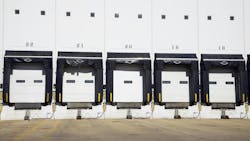How to Ensure Greater All-Season Safety on Loading Docks
Temperature extremes are putting unprecedented strain on loading dock safety and maintenance. For example, a dock in western Colorado experiences a summertime average maximum temperature of 91 degrees F. and a minimum average temperature of 3.5 degrees in winter. Dock seals and shelters can really take a beating due to these fluctuations.
In addition, many cities have urban heat islands that can cause an 8- to 10-degree spike in temperatures because vegetation has been replaced by the built environment. Even cities like Detroit and Dayton—which have relatively mild summers—can experience dock temperatures that are broiling.
In terms of precipitation, some U.S. cities have it considerably worse than others. Syracuse, New York has the dubious distinction of being both the rainiest and snowiest metro area in America: 127 inches of snow annually and 172 days of rain each year. Docks in upstate New York are a prime spot for accidental slips and falls.
Since 25% of all warehouse injuries occur on loading docks, it’s important to be proactive about mitigating weather-related hazards like slippery surfaces, high winds, and prolonged periods of blistering heat.
Here are some ways to help keep workers safe and equipment working properly through all types of unpredictable weather.
Adhere to OSHA Dock Safety Guidelines
OSHA recommends keeping dock surfaces free of oil and water that could cause accidental slips and falls. When fallen leaves cover an oil spot, it’s an accident waiting to happen. OSHA also recommends periodic inspection of dock plates because loose plates can lead to serious falls.
Make a Commitment to Preventive Maintenance
Both freezing temperatures and stifling heat put greater wear and tear on your dock equipment. A year-round preventative maintenance program can help improve dock safety and identify emerging problems before they cause costly downtime and repairs.
Carefully Inspect Dock Seals and Shelters
Dock seals that are properly used and maintained can prevent intense cold or heat from coming inside the facility, lowering your energy costs. Loading dock seals close the small gaps between trucks and the interior of your building, while loading dock shelters are canopies designed to provide even greater protection from the elements. Check seals and shelters for any gaps that could let moisture in. If you notice gapping, it may be time for a replacement.
Use Trailer Restraints and Wheel Chocks Properly
Truck instability can cause serious injuries, so make sure that you use both trailer restraints and wheel chocks. OSHA has found that serious injuries can occur when wheels aren’t securely chocked. Inspect your chocks regularly, looking for cracks or chips that signal it’s time for a replacement. Make sure that chocks are always visible, because they can get completely covered with snow or fallen leaves.
Balance Temperatures with an HVLS Fan
Although heat rises, you can push it back down with a High-Volume, Low-Speed (HVLS) fan. This produces destratification, where warm and cool air are pushed together to create a balanced temperature throughout your facility. It’s a relatively low-cost way to ensure that your HVAC system isn’t working harder than it needs to. HVLS fans help eliminate temperature extremes for your employees while lowering your facility’s carbon footprint. Improved ventilation also helps prevent employee illness due to carbon monoxide exposure from vehicle exhaust.
Protect Your Docks from Weather-Related Hazards
Extreme weather is having a serious impact on dock safety across the U.S. This summer, Phoenix experienced 113 consecutive days of 100-degree-plus temperatures. According to the National Oceanic and Atmospheric Administration, even Northeastern states like Maine and New Hampshire had their warmest summer on record this year. When a dock in New England goes from sweltering summer heat to the inevitable sub-zero winter temperatures, it puts a strain on dock equipment that can lead to premature failure.
Today’s dock seals and shelters are engineered for high reliability. Some use pressure-treated wood that resists cracking and warping, while many have weather-resistant head curtains and fiberglass stays. Despite their rugged design, however, they need to be continuously inspected and maintained—especially in locations with temperature extremes and heavy precipitation.
You can stay one step ahead of weather-related dock equipment failure simply by sticking to a year-round preventive maintenance program. It’s the most effective way to ensure dock safety while boosting productivity.
About the Author
Johnny Allen
Johnny Allen is SVP of Construction Services at Miner, the leading self-perform, national service partner for smarter, safer loading docks, and a division of OnPoint Group.
